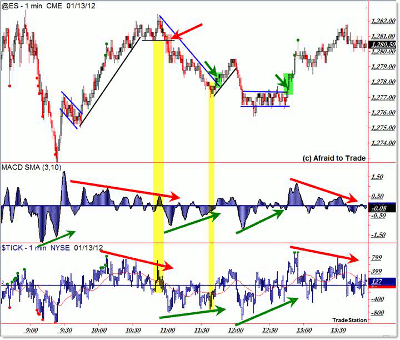Recent price action in the S&P E-mini (ES) futures serves as an example of how spotting divergences can help traders locate low-risk, high-probability entry and exit signals for intraday trading.
Dual intraday divergences can be very helpful in pinpointing short-term turns (reversals) in price that create ideal, low-risk, high-probability trade set-ups for intraday index futures or ETF traders.
Let’s highlight a good example reference from Friday, January 13 using the @ES futures contract as our proxy.
Without delving into too much detail of reversal logic, let’s just focus our attention on the price action along with two supporting indicators:
- The 3/10 MACD oscillator, a momentum oscillator (MACD with custom settings 3 and 10)
- The NYSE TICK, a market internal indicator
You could substitute any unbound momentum-style oscillator such as rate of change for your momentum indicator to get a similar effect.
See related: How to Use the NYSE TICK Intraday
What we’re identifying are divergences:
- A positive divergence occurs when price is declining (making lower lows) yet the oscillator forms higher lows
- A negative divergence similarly develops when price rises but the oscillator forms lower highs
Price can form single divergences or multi-swing (multiple) divergences.
Logically, the more divergences that develop within a swing, the greater the odds of price reversing.
That’s the basis of using oscillators for confirmation/non-confirmation.
Friday’s session gave us a cluster of both positive and negative dual divergences.
Dual divergences occur when both the momentum (price-based) and TICK (market internal) indicators form corresponding divergences relative to the price swing in motion.
The first major negative dual divergence occurred near 11:00 am CST, which was then triggered (for a potential trade entry) on the signal from price breaking either the rising trend line or preferably the horizontal trend line near 1,281. The stop would go slightly above the prior swing high in the event the uptrend continued.
Similarly, there were two positive divergence situations near 11:40 am and 12:45 pm CST. The first divergence produced only a very small swing to the upside, while the second opportunity resulted in a swing reversal—and a break of a sideways rectangle pattern—for a larger swing higher.
Each trader must decide whether to use aggressive (entering early and using a wider relative stop to play for a larger target) or conservative (entering only after proof of a trend line break while using tighter stops and smaller targets) trading tactics when building trades out of this type of swing reversal logic.
Generally, the trade is exited either into a fixed target or on a corresponding opposite divergence, which may trigger a new trade.
Divergence situations like this can be used as trade exit signals (perhaps from another set-up), not just entry signals.
By Corey Rosenbloom, CMT, trader and blogger, AfraidToTrade.com
I’ll cover this topic and incorporate divergence work into multiple time frame analysis during my upcoming presentation at the New York Traders Expo.



















